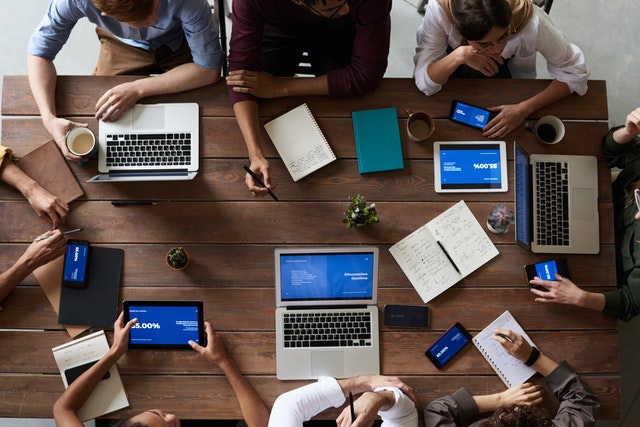5 Ways Technology Is Transforming Retail

Technology has significantly reshaped how people live, shop, and make everyday choices. This transformation has brought about a major change in shopping trends and customer preferences. In order to keep up with these changes, the retail sector must consistently adapt and grow.
The rise of e-commerce has enabled shoppers to effortlessly explore products and have them delivered to their doorstep, eliminating the need to travel or incur additional expenses. Additionally, technological advancements have introduced innovative experiences, such as virtual trials of items like sunglasses or hats, all through a smartphone’s camera. This allows customers to enjoy online shopping just as they would in a physical store, and that too without leaving their homes.
Retailers aiming to attract customers and provide an exceptional shopping journey must acknowledge that technology and e-commerce have transformed and revolutionized how people shop. The old ways of engaging customers in brick-and-mortar settings simply cannot suffice. Instead, retailers need to embrace innovation.
Technology like interactive displays can tailor the shopping experience for diverse customer profiles. Similarly, automating certain procedures like the checkout process through innovations such as barcode scanning can significantly enhance efficiency and customer convenience.
For instance, utilizing advanced barcode scanning software from CodeCorp can expedite the point-of-sale process. This can further improve overall customer experience and increase the likelihood of repeat visits to a physical store.
Ways Technology Is Transforming Retail
Here is how technology is transforming the retail industry:
1. Bridging the Gap Between Online and Offline Shopping Experiences
Bridging the gap between online and offline shopping experiences is all about providing customers with the best products at the right prices while minimizing hassle. This has led to the emergence of shopping trends that blend elements from both practices. A perfect example of this is BOPIS (Buy Online, Pick up In-Store).
Modern retailers are dedicated to establishing an omnichannel shopping environment. This ensures that users enjoy a consistent shopping experience whether they’re using a mobile app, browsing the website, or physically shopping in a store.
BOPIS takes this a step further by allowing customers to place orders online and conveniently retrieve them from nearby stores. This ultimately helps retailers cut down on delivery times and costs.
2. Understanding Customer Needs Better
Technological advancements are helping retailers gain a deeper understanding of customer preferences through innovative means. By adopting technologies like Artificial Intelligence (AI) and Machine Learning (ML), retailers can get access to customer interests, emerging trends, and purchasing patterns. Leveraging these insights, retailers can craft customized shopping experiences tailored for distinct customer segments.
These insights enable retailers to not only understand what products or services are currently popular but also to anticipate future trends and adapt their services and products accordingly. Additionally, AI-driven analytics allows retailers to understand the underlying motivations and emotions driving customer choices. This level of understanding enables brands to establish more meaningful and lasting connections with customers.
3. Helping Retailers Lower Operating Costs and Manage Inventories and Warehouses
The retail sector has undergone a remarkable transformation with the integration of automation and robotics, offering various advantages to businesses, especially in warehouse operations. While there’s a common concern that automation could replace human workers, the reality has been different. Take Amazon as an example. The company’s robots work alongside human employees, enhancing their packing efficiency. Previously, an average Amazon worker could pack around 100 products per hour. However, with the introduction of robots, this number has quadrupled.
Other retailers are using automation and robots similarly to lower operating expenses and manage their warehouses and inventories more efficiently. They’re also using artificial intelligence to help with demand forecasting, inventory management, etc. Incorporating these technologies is giving many retailers an edge by helping them lower costs and offer a better overall shopping experience.
4. Create a Better Shopping Experience
Technologies like interactive displays are helping retailers create a better shopping experience. These displays serve multiple purposes. They help customers understand product features and advantages, reducing the need for in-store mobile usage, which could lead to online price comparisons and potential e-commerce bargains.
However, that’s not the only advantage of using interactive displays. Leading retailers have adopted interactive displays to guide customers through a unique brand experience. In-store displays now showcase videos that effectively convey the brand’s identity, mission, and values. This approach helps businesses establish a deeper connection with customers.
5. Stores without Employees
Advanced technologies like Augmented Reality (AR), Artificial Intelligence (AI), and the Internet of Things (IoT) are changing the way stores appear and operate. For instance, the Internet of Things lets stores gather data from connected devices, allowing them to offer personalized experiences to customers.
Some fashion stores now have smart mirrors in dressing rooms. These mirrors suggest products to potential customers based on their interests and preferences. Similarly, smart stores are becoming more and more common. These stores use IoT, AI, and AR to offer a modern shopping experience with smart shelves and sensors.
Conclusion
The retail industry has been particularly affected by recent developments. Even before COVID-19 wreaked havoc, technological advancements were already disrupting the sector. However, this doesn’t signal the end for retailers. On the contrary, the retail industry remains expansive.
Retailers today must focus on incorporating technology to enhance the in-store shopping experience to fulfill the needs and expectations of modern consumers. Through the utilization of IoT, AI, and AR technologies, retailers have a prime opportunity to offer a distinctive shopping journey that resonates deeply with customers.
These innovative tools pave the way for a one-of-a-kind in-store experience, one that has the potential to attract more visitors to brick-and-mortar settings.






